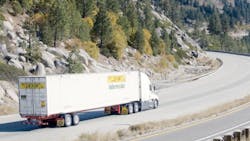J.B. Hunt execs see ‘nice step forward’ in Q2 volumes but cut spending plans
The leaders of J.B. Hunt Transport Services Inc. this week said the Arkansas-based carrier saw decent volume gains late in the second quarter at several of its businesses, a development president and CEO Shelley Simpson said has moved her team “closer to calling some kind of inflection.”
Simpson and her lieutenants told analysts July 16 that they saw signs of more normal seasonal activity in late spring. Among the bright spots was a double-digit increase in intermodal work from Southern California and June increases above historical averages in J.B. Hunt’s brokerage and truckload businesses.
“We can’t quite see it fully in our results yet but we took a nice step forward on our volumes,” COO and president of contract services Nick Hobbs said of truckload and brokerage volumes on a conference call.
Still, the executives added, some of the improvements they saw likely included a pulling forward of peak-season shipping. On top of that, they continue to wrestle with low rates due to excess capacity, and they said a number of J.B. Hunt’s customers are “a little bit skittish about what they can expect” from the quarters ahead.
In large part due to poor pricing, J.B. Hunt posted a second-quarter net profit of $136 million, which was 28% less than its bottom line of the same period in 2023. Operating revenues excluding fuel surcharges fell to $2.55 billion from $2.71 billion a year earlier, with the company’s intermodal segment—its biggest at about half of operating revenues—posting a volume drop of 1% primarily because its eastern network loads slipped 7%. Operating income for the quarter fell to $206 million from nearly $271 million in the prior year.
See also: J.B. Hunt still looking at the long run after disappointing Q1
The lingering uncertainty about when more excess capacity will exit the market as well as just how strong demand will be in what remains of 2024—“I don't think that two weeks is going to make a trend—or two months. What we need to do is get actual data from our customers,” EVP of sales Spencer Frazier told analysts—have led Simpson and her team to significantly trim their 2024 capital spending forecast. Instead of its previous plan to spend between $800 million and $1 billion this year on trucks, trailers, and real estate, executives now expect to invest between $650 million and $700 million.
The J.B. Hunt team’s comments about a solid improvement in volumes late in Q2 were echoed in the latest Cass Transportation Index Report, which showed a 1.8% drop in seasonally adjusted volumes in June. Year over year, Cass analysts noted, shipments were down 6%, which was in line with May’s number as well as 2023’s 5.5% decline.
“If there’s any silver lining, this is starting to look like a real bottom,” the analysts wrote.
Simpson this week wasn’t prepared to go further, though, and call an upturn. J.B. Hunt needs a “clear line of sight” to go that far.
“But I will say there are signs that tell us that things are moderating or getting better,” she said of a true inflection. “You’re hearing [from the J.B. Hunt team] a tone that says, ‘Listen, we have better signals. It doesn’t mean that they’re great.’”
Shares of J.B. Hunt (Ticker: JBHT) slid nearly 7% during the generally rough June 17 trading session after its leaders announced Q2 results and was down another 2% the next day. Year to date, they have given up about 17% of their value, clipping the company’s market capitalization to about $16.5 billion.
About the Author
Geert De Lombaerde
Senior Editor
A native of Belgium, Geert De Lombaerde has more than two decades of experience in business journalism. Since 2021, he has written about markets and economic trends for Endeavor Business Media publications FleetOwner, Healthcare Innovation, IndustryWeek, Oil & Gas Journal, and T&D World.
With a degree in journalism from the University of Missouri, he began his reporting career at the Business Courier in Cincinnati. He later was managing editor and editor of the Nashville Business Journal. Most recently, he oversaw the online and print products of the Nashville Post and reported primarily on Middle Tennessee’s finance sector and many of its publicly traded companies.

